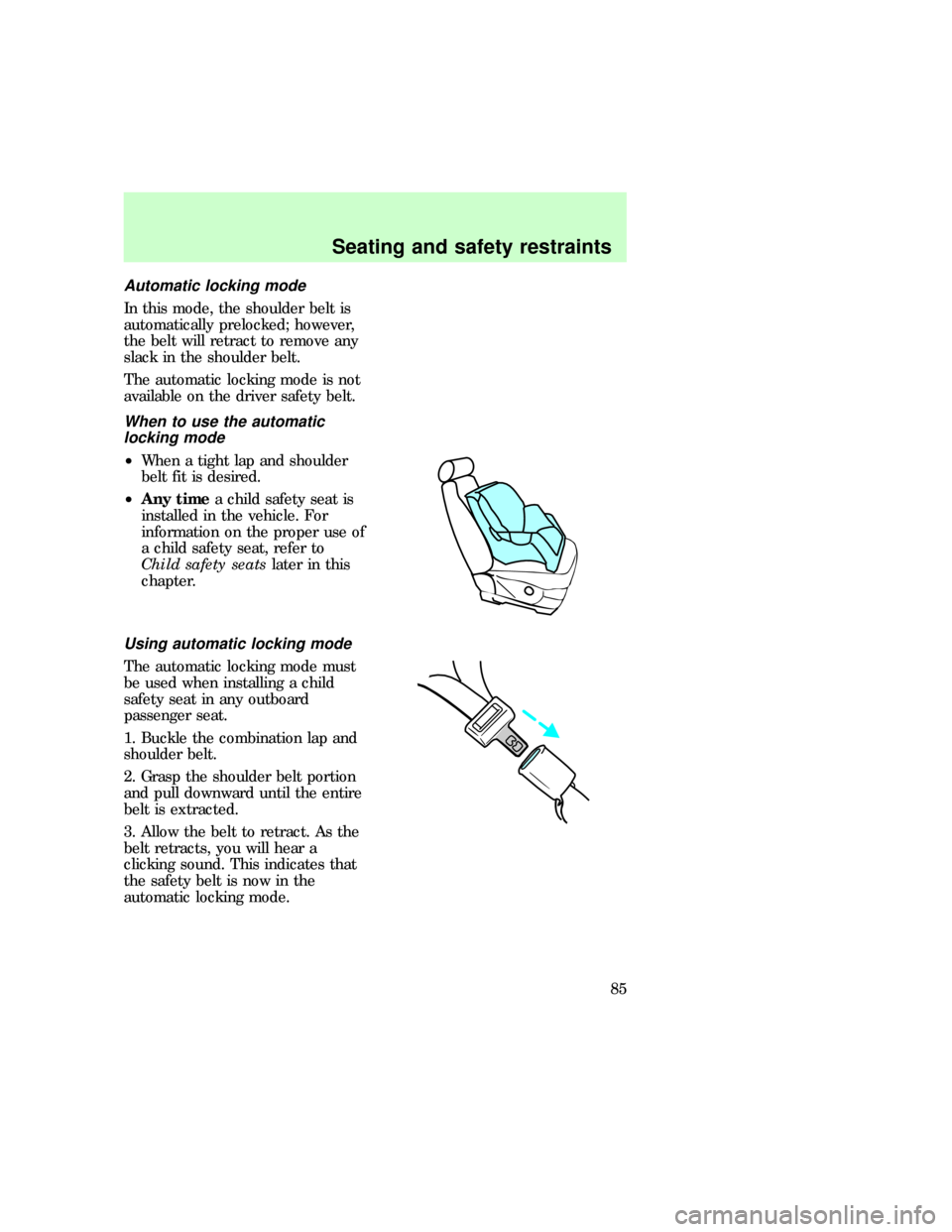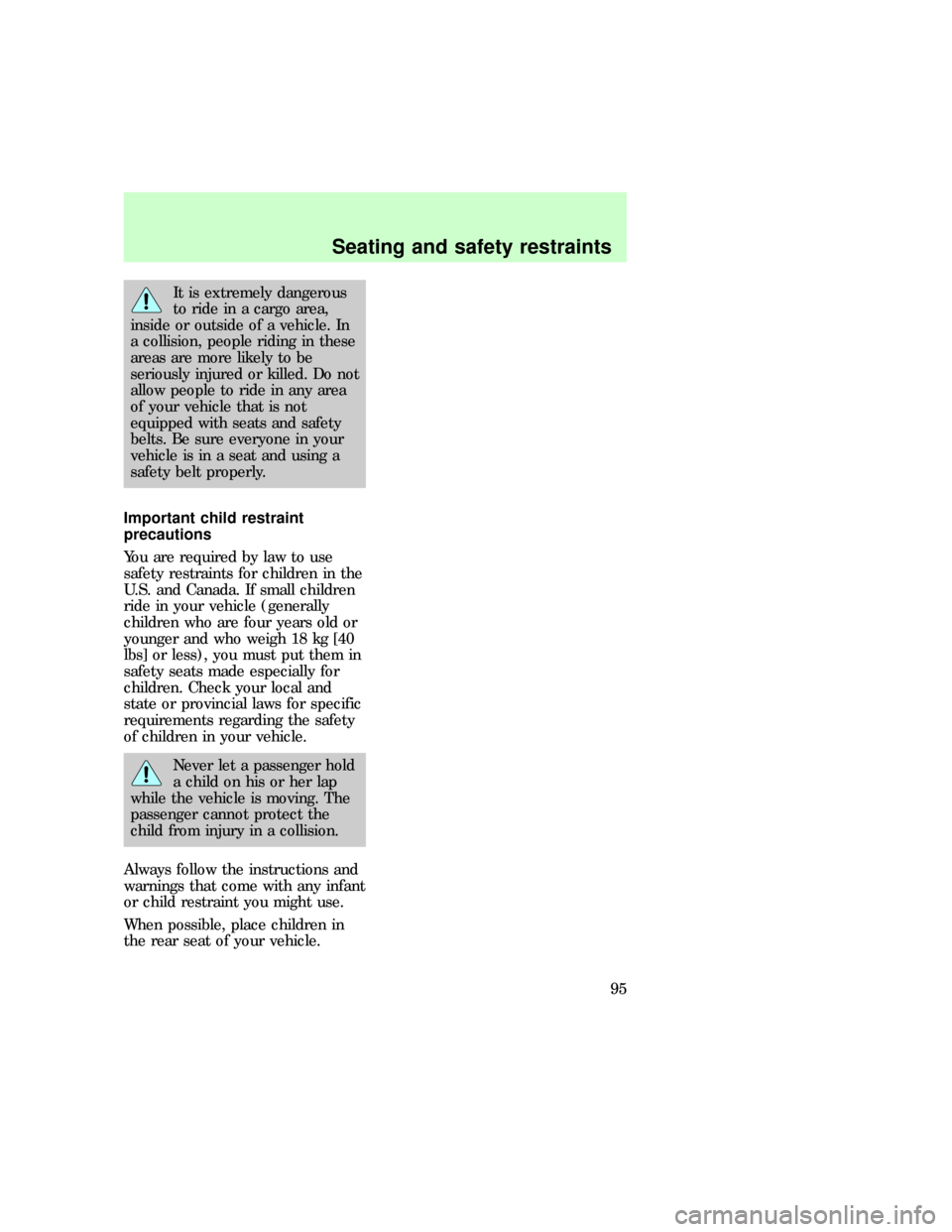Page 32 of 236
The EATC feature will maintain a
selected temperature and
automatically control airflow. You
may manually override the EATC
operation. The EATC will only
operate with the ignition in the On
position.
To maximize system efficiency:
²Do not put items under the
front seats that will interfere
with the air flow to the rear
seats.
²Keep the air intake vents clear
of any snow, ice or leaves.
Automatic operation
To turn on the EATC:
²Press AUTO or any the six
override controls.
²Select the desired temperature.
To turn off the EATC:
²Press the OFF control.
²When the system is off, the
display window will be blank.
When AUTO is selected, the
system will automatically
determine fan speed and airflow
location and under normal
conditions should need no
additional adjustment.
¡F
AUTO
uno_automatic_operation
uno_temperature_select
Controls and features
33
Page 78 of 236
SEATING
Adjusting bench seating
Folding rear seats (if equipped)
If your vehicle is equipped with a
built-in child safety seat, the
seatback cannot be folded down
unless the built-in child seat is
fully stowed.
1. Press the lower release control
downward to unlatch the seatback.
2. Rotate the seatback downward
into the load floor position.
3. Press down on the top outboard
area of the seatback until a click is
heard. The seat is now latched in
the load floor position.
Returning to the upright
position
1. Press downward on the upper
outboard corner of the seatback
and hold.
2. Pull the release handle upward
to unlatch the seat.
3. Rotate the seatback upward
until the seatback latches in the
upright position. The seatback will
click when it is locked into
position.
uno_adjusting_bench
uno_adjust_man_bucket
Seating and safety restraints
79
Page 79 of 236
Manually adjusting the captain's
chair
Lift to move the seat forward or
backward.
Pull up to recline the seat.
Adjusting the power front seats
(if equipped)
Pull up to recline the seat.
uno_adjust_power_seat
Seating and safety restraints
80
Page 81 of 236
Press to increase (+ ) or decrease
(-) lumbar support.
Memory seats (if equipped)
This system allows automatic
positioning of the driver seat to
three programmable positions.
²To program position one, move
the driver seat to the desired
position using the seat controls.
Press the SET control. The SET
control indicator light will briefly
illuminate. While the light is
illuminated, press control 1.
²To program position two, repeat
the previous procedure using
control 2.
²To program position three,
repeat the previous procedure
but press controls 1 and 2
simultaneously.
A position can only be recalled
when the automatic transmission
gearshift is in P (Park) or the
manual transmission gearshift is in
N (Neutral). A memory seat
position may be programmed at
any time.
+–
SET
12
uno_remote_seat_controls
uno_seat_belts
Seating and safety restraints
82
Page 84 of 236

Automatic locking mode
In this mode, the shoulder belt is
automatically prelocked; however,
the belt will retract to remove any
slack in the shoulder belt.
The automatic locking mode is not
available on the driver safety belt.
When to use the automatic
locking mode
²When a tight lap and shoulder
belt fit is desired.
²Any timea child safety seat is
installed in the vehicle. For
information on the proper use of
a child safety seat, refer to
Child safety seatslater in this
chapter.
Using automatic locking mode
The automatic locking mode must
be used when installing a child
safety seat in any outboard
passenger seat.
1. Buckle the combination lap and
shoulder belt.
2. Grasp the shoulder belt portion
and pull downward until the entire
belt is extracted.
3. Allow the belt to retract. As the
belt retracts, you will hear a
clicking sound. This indicates that
the safety belt is now in the
automatic locking mode.
uno_when_to_use_almode
uno_using_auto_locking_mode
uno_cancel_air
Seating and safety restraints
85
Page 90 of 236
Rear-facing child seats or
infant carriers should
never be placed in the front
seats.
How does the air bag
supplemental restraint system
(SRS) work?
The SRS is designed to activate
when the vehicle is in a collision,
similar to hitting a fixed barrier
head on at 12±24 km/h (8±14
mph).
The fact that the air bags did not
inflate in a collision does not mean
that something is wrong with the
system. Rather, it means the forces
were not of the type sufficient to
cause activation.
uno_how_work
Seating and safety restraints
91
Page 93 of 236
Disposal of air bags and air bag
equipped vehicles
For disposal of air bags or air bag
equipped vehicles, see your local
dealership or qualified technician.
Air bags MUST BE disposed of by
qualified personnel.
CHILDREN AND SAFETY
RESTRAINTS
To prevent the risk of
injury, make sure children
sit where they can be properly
restrained.
Do not leave children,
unreliable adults, or pets
unattended in your vehicle.
Safety belts and seats can
become hot in a vehicle
that has been closed up in sunny
weather; they could burn a small
child. Check seat covers and
buckles before you place a child
anywhere near them.
uno_child
Seating and safety restraints
94
Page 94 of 236

It is extremely dangerous
to ride in a cargo area,
inside or outside of a vehicle. In
a collision, people riding in these
areas are more likely to be
seriously injured or killed. Do not
allow people to ride in any area
of your vehicle that is not
equipped with seats and safety
belts. Be sure everyone in your
vehicle is in a seat and using a
safety belt properly.
Important child restraint
precautions
You are required by law to use
safety restraints for children in the
U.S. and Canada. If small children
ride in your vehicle (generally
children who are four years old or
younger and who weigh 18 kg [40
lbs] or less), you must put them in
safety seats made especially for
children. Check your local and
state or provincial laws for specific
requirements regarding the safety
of children in your vehicle.
Never let a passenger hold
a child on his or her lap
while the vehicle is moving. The
passenger cannot protect the
child from injury in a collision.
Always follow the instructions and
warnings that come with any infant
or child restraint you might use.
When possible, place children in
the rear seat of your vehicle.
uno_important_precautions
Seating and safety restraints
95